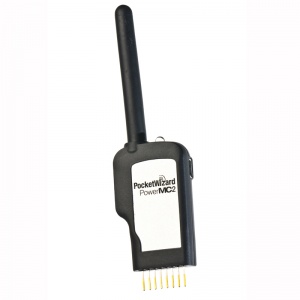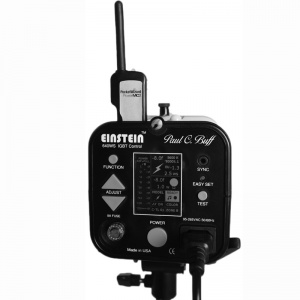PowerMC2
Contents
Receiver with ControlTL® for Einstein™ E640 Flash
The PowerMC2 Receiver Module enables remote power control of Einstein™ E640 flashes using PocketWizard ControlTL technology. With a MiniTT1 Transmitter or FlexTT5 Transceiver on your camera and a PowerMC2 plugged into your Einstein™ E640 flash, you can now adjust the flash power settings directly from the camera position. Add the AC3 ZoneController and you can control three different zones of lights in 1/3-stop increments with up to a six-stop range. Utilize PocketWizard’s unique features such as HyperSync and Optimized Rear Curtain Sync for maximum control of your lighting.
Using your PowerMC2
1. Connect the PowerMC2 to your Einstein™ E640 Flash via the remote port, then power on the flash.
2. Select the Channel and Zone A, B, or C via the E640’s LCD.
3. Set up your PocketWizard transmitter and take pictures normally.
4. Adjust the camera’s Flash Exposure Compensation (FEC) to adjust the power of your remote flash. See the Basic Power Control section for more information about FEC.
Make sure all your radios are set to the same PocketWizard channel.
The Status LED blinks Green every few seconds to indicate normal operation. It will blink Red in sync with a trigger.
Momentarily pressing TEST will test trigger the flash.
Your PowerMC2 needs to be on the same channel as your transmitter. Channels can be set via the Einstein’s built-in LCD. The PowerMC2 is capable of receiving on either ControlTL Channels for use with ControlTL radios like the MiniTT1 and FlexTT5 or Standard Channels for triggering with the Plus II, MultiMAX, and Sekonic meters.
To set the channel, press the Einstein’s™ FUNCTION button until the Channel selection box is highlighted, and then change channels with the ADJUST buttons. Press the FUNCTION button again to specify a zone. When using ControlTL Channels, or Standard Channels 17-32, you can specify zone A, B, or C.
Note: When receiving on Standard Channels, the PowerMC2 will be unable to do any form of PowerTracking, or remote Manual Power Control. You must be using a ControlTL radio in ControlTL radio mode for the Einstein to be able to engage in any form of ControlTL feature.
ControlTL
PocketWizard’s newest firmware platform taps into the camera’s digital communications to enable an entirely new level of remote flash capability through our proven radio system. ControlTL allows remote TTL systems as well as Manual Power Control. ControlTL firmware is configurable and upgradeable for “future-proof” continuous improvement.
Manual Power Control
Adjust the manual power settings of your remote Einstein flash directly from a AC3 ZoneController, or master flash mounted on your on-camera MiniTT1 or FlexTT5. You can independently control the power output of up to three remote groups of lights (you can have as many lights in each group as you want) from full power down to the lowest setting through the user interface on the back of the master flash or with the dials of the AC3 ZoneController. Now you can work with total control with your remote lights, without leaving your shooting position.
HyperSync
Our patent pending HyperSync® technology allows photographers to achieve faster X-sync speeds with full power flash. That extra speed can be used to freeze action or cut ambient light - both of which can produce results never possible before. HyperSync works automatically with the PowerMC2. All you need is a MiniTT1 or FlexTT5 on camera to gain the benefits of HyperSync. While performance varies by the camera and flash equipment being used, HyperSync will get the maximum possible out of any configuration.
PowerTracking
When working with certain manual flashes, you can change any of your settings on your camera and the system adjusts for those settings. Change your camera's exposure compensation to adjust the flash output, or make adjustments in aperture or ISO and the system balances your flash for proper exposure.
Basic Power Control
With only a MiniTT1 or FlexTT5 on your camera, your camera’s FEC (Flash Exposure Compensation) control will adjust your flash power output level for all your PowerMC2-connected flashes as shown in the table below.
<div align="center"
| Camera FEC/EC - or - AC3 Power Dial in Manual |
Einstein E640 Power Output |
| +3 | 1/1 |
| +2.7 | 1/2 + 0.6 |
| +2.3 | 1/2 + 0.3 |
| +2 | 1/2 |
| +1.7 | 1/4 + 0.6 |
| +1.3 | 1/4 + 0.3 |
| +1 | 1/4 |
| +0.7 | 1/8 + 0.6 |
| +0.3 | 1/8 + 0.6 |
| 0 | 1/8 |
| -0.3 | 1/16 + 0.6 |
| -0.7 | 1/16 + 0.3 |
| -1 | 1/16 |
| -1.3 | 1/32 + 0.6 |
| -1.7 | 1/32 + 0.3 |
| -2 | 1/32 |
| -2.3 | 1/64 + 0.6 |
| -2.7 | 1/64 + 0.3 |
| -3 | 1/64 |
</div>
PocketWizard Utility
Use the PocketWizard Utility software with the on-board USB port to program the PowerMC2 to any PocketWizard channel and zone as well as many other custom settings. ControlTL radios can be upgraded whenever updates and feature enhancements are available.
PowerMC2 Receiver Utility Settings
Exposure Tab
- Flash Exposure Compensation (FEC): Offsets exposure for the connected flash only. This setting can be used as a simple FEC control for an individual flash, or it can be used to set flashes on the same zone to different power outputs or to balance them. This setting is cumulative with other FEC values set in the system. This control can also be used to adjust where the PowerTracking center point aligns with your camera’s FEC control. See the FEC NOTE and Camera FEC Range section for more information. Default = 0.0
Sleep Tab
- Modeling Light Sleep: The modeling light will turn off after the set time if no triggers are received. Uncheck the box to have the modeling light stay on. Default = Enabled at 600 seconds (10 minutes)
- Hibernate: When an Einstein™ E640 Flash is turned off, it’s actually in STANDBY Mode and can be turned on remotely via a ControlTL radio. Uncheck the box to have the E640 never automatically power off. Default = Enabled at 60 minutes
Important: Make sure to press the "Apply Changes" button to save your settings.
FlexTT5 or MiniTT1 Transmitter settings that affect the use of a PowerMC2:
Modeling Tab
- Modeling Light Control: Check this box to control modeling light behavior from the transmitter. Default = Enabled
- Control Mode: Determines when the modeling light will go to its active setting. Set to Camera Wake to have the modeling light go active when the camera’s shutter release is half-pressed. Set to AF-Assist to have the modeling light go active only when the camera requests auto-focus assist. Default = Camera Wake
- Modeling Light Autotrack: Enable this control for the modeling light level to track with the camera exposure or AC3 Power Dial settings. Default = Enabled
- Modeling Light Active XX%: Sets the active output level of the modeling light if Autotrack is not used. Default = 100%
- Modeling Light Sleep: Check this box to have the modeling light automatically go to a set output level after a set time. If this box is unchecked, the modeling light will never sleep. Default = Enabled
- Modeling Light Sleep XX%: Sets the output level of the modeling light when it sleeps. Default = 10%
- Modeling Light Delay After Camera Sleeps: Sets the number of seconds after the camera sleeps (meters go inactive) when the modeling light will go to its sleep value. Default = 30 seconds
PowerTracking Tab
- PowerTracking Control: Adjusts how ControlTL-capable remote studio flashes, like flashes connected to a PowerMC2, respond to the AC3 in Auto Mode, or to a ControlTL Transmitter with no AC3. See the ControlTL & PowerTracking section for information.
- Full Manual (default): Turns off PowerTracking for aperture and ISO. See the Camera FEC Range and Basic Power Control section for more information.
| Nikon Only |
- With no AC3 ZoneController on the transmitter, only the camera’s FEC/EC control will adjust flash power output level.
| Canon Only |
- With no AC3 ZoneController on the transmitter, the camera’s ISO and FEC controls will adjust flash power output level.
- With an AC3 ZoneController on the transmitter, any zones set to Auto Mode will operate as Center on ISO & Aperture with First Shot (see below) when this control is set to Full Manual. AC3 Manual Mode can be used to adjust flash output power manually with an AC3.
- Center on ISO & Aperture with First Shot: Aperture and ISO as set on the camera for the first exposure will be aligned with the ControlTL center point (3 stops down from your flash’s maximum output power). For example, if your camera is set to ISO 100 and F:5.6 for its first exposure, then those exposure settings will yield a flash output power of 1/8. Adjustments to aperture, ISO, and FEC will adjust flash output power accordingly, as will adjusting the Power Dial on AC3 zone in Auto Mode. See the Automatic PowerTrackingsection for more information.
- Center on ISO & Aperture: Lets you set the aperture and ISO that will be aligned with the ControlTL center point (3 stops down from your flash’s maximum output power). Adjust the drop-down boxes for the Aperture Center-On and ISO Center-On values you want to use
- Center on Aperture Only: PowerTracking will only work with aperture changes. Set the desired aperture using the Aperture Center-On control. ISO changes will be ignored for PowerTracking for Nikon cameras, and FEC/ISO changes for Canon cameras.
- Center on ISO Only: PowerTracking will only work with ISO changes for Nikon cameras and FEC/ISO changes for Canon cameras. Set the desired ISO using the ISO Center-On control. Aperture changes will be ignored for PowerTracking.
- No Change (trigger only): Turns off PowerTracking and the Power Dials on the AC3 will not adjust the power output of your remote flash. Use this setting if another photographer is controlling the flash’s manual power output, like when sharing flashes with another photographer and you want to use the exact same manual flash output power.
Specifications:
| Frequency | 340.00 - 354.00 US FCC/IC 433.42 - 434.42 MHz - CE |
| Channels | 52 Channels over 26 Frequencies - US FCC/IC 35 Channels over 5 Frequencies - CE |
| Antenna | 2.7" (6.9 cm) rubberized |
| Mounting | Eight-pin remote socket |
| Zone Select Switch | A-B-C Plus channel "D" if receiving on a MultiMAX channel. |
| Status Indicator | LED: Green, Amber, Red Status indications |
| USB | USB Compliant 2.0, Mini-B Connector, 5VDC regulated, 100mA, Pin 1 Positive, Pin 4 Ground |
| Operating Temperature | Above -15° C (5° F) and below 50° C (120° F) |
| Storage Temperature | Above -30° C (22° F) and below 85° C (185° F) |
| Construction | high impact plastic, rubberized antenna, RoHS Compliant |
| Power | Receives power from attached flash |
| Dimensions | 4.66" (11.84 cm) long x 1.29" (3.27 cm) wide x .43" (1.09 cm) depth |
| Weight | .77 ounces (21.83 grams) |
| Requirements | Must be used in conjunction with a MiniTT1 or FlexTT5 on camera for power control capability. May be paired with any PocketWizard transmitter or transceiver for simple triggering. |




